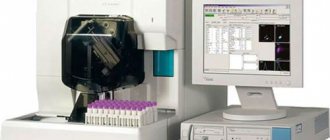Hematocrit, or hematocrit number, is a value that is determined by the ratio of the volume of blood cells (erythrocytes, platelets, leukocytes) to the volume of total blood. This value is designated as Ht. Since red cells make up 99% of the total number of blood cells, the hematocrit is considered to be the portion of the blood that is erythrocytes. The value is measured in percent or liters.
If a blood test shows that the hematocrit is low, you should find out the reasons, of which there may be quite a few.
Hematocrit norm
In general, the norm is 40-45%, or 450 ml per liter (0.45 l/liter) of blood. But it is not the same for people of different genders and ages.
For men, the normal hematocrit value is:
- from 18 to 45 years old – 39-49%;
- from 45 years old – 40-50%.
For women:
- from 18 to 45 years old – 35-45%;
- from 45 years old – 35-47%.
For children:
- for newborns – 33-65%;
- up to a year – 33-44%;
- from 1 to 5 years – 32-41%;
- from 6 to 11 years – 33-44%.
For pregnant women, a slight decrease in hematocrit is allowed.
It is red blood cells that determine the hematocrit value
Norm
The hematocrit norm differs depending on age and gender. In newborns, the rate is considered high and the norm is 42% - 65%. As one grows older, it decreases; in older people, a minimum level of hematocrit is observed. For adults aged 18-65 years, the norm is:
- For men - 41% - 53%.
- For women - 36% - 46%.
Deviations from the norm can be observed during pregnancy. From about 20 weeks, the indicator decreases due to an increase in the amount of liquid part of the blood for physiological reasons. After childbirth, the hematocrit quickly returns to normal values in the absence of pathologies.
Deviations towards increasing hematocrit are recorded:
- In smokers, due to oxygen starvation of tissues, which leads to an increase in the production of red blood cells.
- When rising to a high altitude, the production of red blood cells increases due to the body's adaptation to the reduced oxygen concentration in the air.
- For stress and traumatic shock, which is characterized by intense pain.
- When taking corticosteroid drugs and diuretics,
Deviations towards a decrease in hematocrit are recorded:
- With prolonged immobility.
- When taking antiplatelet agents and anticoagulants that thin the blood.
- Against the background of high fluid consumption.
- For chronic alcoholism.
Causes
Most often, a low hematocrit signals anemia. In addition, it can be reduced in some diseases, including dangerous ones. The main reasons for a decrease in hematocrit are as follows:
- severe bleeding caused by injuries, fractures of large bones, internal bleeding, gynecological diseases, menstruation;
- strict diet, fasting;
- •sweating for a long time;
- slow process of red blood cell formation, impaired hemoglobin synthesis in sickle cell anemia, thalassemia;
- premature death of red blood cells due to genetically determined cell defects, autoimmune and toxic effects on them;
- blood thinning;
- hyperproteinemia, or high levels of proteins in the blood, due to pathological processes such as multiple myeloma, hemoblastosis and others;
- accumulation of large amounts of fluid in the body (overhydration) due to intravenous infusions, renal failure, infectious diseases;
- pregnancy (second half).
A decrease in hematocrit is observed in the following diseases:
- anemia, in which the number of red blood cells is reduced;
- oncological diseases of the bone marrow, malignant tumors leading to decreased production of red cells;
- chronic inflammatory processes;
- vascular diseases;
- kidney disease (renal artery stenosis, renal failure, polycystic kidney disease);
- liver diseases.
Hematocrit - what is it, what does it depend on
Hematocrit analysis provides data on the ratio of the volume of red blood cells to the total volume of blood; sometimes this indicator refers to the ratio of the volume of all formed elements to the total volume. There is no particular difference between the interpretations; 99% of the blood cell volume is made up of red cells. More often, hematocrit is recorded as a percentage of the total volume, less often as a ratio of cell volume to total blood volume.
This indicator is determined as part of a general blood test complex. It is classified as secondary and is calculated based on data on the number of red blood cells. Occasionally, direct measurement of hematocrit is performed by centrifuging the sample. This procedure allows you to separate plasma from formed elements and directly measure this indicator.
False results
If you donate blood after blood loss, including during menstruation, the result may be distorted, that is, underestimated. Also, a false result may be obtained if blood is drawn from a site where intravenous infusions were recently performed, and the blood is thinned by a drug. Distortion is possible if the veins were compressed with a tourniquet for a long time or blood was taken when the person was in a supine position. In this case, the analysis must be taken again.
After centrifugation, the formed elements settle to the bottom of the capillary, and the plasma remains at the top - thus determining the hematocrit level
Indications
The appointment of an OAC, which includes a hematocrit study, is included in the standard patient examination plan and is mandatory:
- when undergoing a medical examination and/or medical examination;
- if any disease is detected or suspected by a clinic doctor;
- in preparation for planned surgery;
- during hospitalization (on the day of admission and on the eve of discharge).
Calculation of the hematocrit number is required for certain indications;
- blood clotting disorder;
- dehydration (dehydration);
- assessment of the degree of anemia (anemia), polycythemia (increase in blood cells);
- bleeding.
Hematocrit during pregnancy
In women during pregnancy, the hematocrit may be below normal. This is explained by the fact that blood volume increases due to plasma. During this period, this figure can be 33%, and this is considered normal. Special treatment, as a rule, is not required, and in the third trimester the indicator returns to normal naturally due to the intensive elimination of excess fluid. However, we must not forget that during pregnancy you need to constantly monitor your blood composition. Pregnant women often develop iron deficiency anemia, in which Ht is less than normal. Its decrease in expectant mothers may also be associated with overhydration.
A low hematocrit can lead to illness. In this case, you need to consult a doctor who will prescribe the necessary treatment.
Treatment of crises and complications
The main goal of treatment is to prevent crises and reduce the risk of complications, such as kidney and liver pathologies, stroke, heart attack, visual impairment and prolonged depression. Doctors, as a rule, recommend the drug Hydroxycarbamide for any type of disease: it reduces the risk of developing anemia and speeds up recovery.
The patient’s well-being is also positively affected by:
- minimizing stress and overexertion;
- moderate exercise;
- proper consumption of drinking water.
Quite often, cases of false hematocrit are observed, for example, due to incorrect general analysis, long clamping of the vein with a tourniquet, taking the analysis in an inappropriate position, etc.
Critical hematocrit values require immediate blood transfusion to save the patient’s life.
Reduced hematocrit in children
If a child’s hematocrit value is less than normal, what does this mean? To find out, a survey is required. There may be several reasons for a decrease in hematocrit in a child, including:
- reduced rate of red blood cell formation in the bone marrow;
- rapid breakdown of red blood cells;
- high levels of protein in the blood;
- large volume of circulating blood;
- bleeding.
Anemia is the most common cause of low hematocrit in a child.
Hematocrit increased
An increase in the level of red blood cells detected in a hematocrit analysis may indicate various pathological conditions. The most common:
- Primary erythrocytosis. It occurs as a result of overactive production of red blood cells, including immature forms. May indicate the development of tumors in the bone marrow.
- Secondary erythrocytosis. Develops as a consequence of pathologies of the respiratory and cardiovascular systems (heart defects, respiratory failure).
- Reduced plasma volume. May indicate the development of peritonitis, leukemia, kidney disease. Often occurs with extensive burns, when blood plasma sweats through the damaged dermis.
- Dehydration. Observed in uncompensated diabetes mellitus, it can result from diarrhea, vomiting, excessive sweating and lack of fluid in the diet.
Erythrocytosis can develop in heavy smokers, especially if smoking has led to secondary damage to the respiratory system and heart. In this case, the body turns on mechanisms to compensate for insufficient oxygenation due to a significant increase in the number of red cells.
An increase in hematocrit is not always a consequence of disease. An increase in the number of red blood cells is considered normal for residents of mountainous areas and professional climbers. When exposed to high altitude conditions for a sufficiently long time, the body compensates for the lack of oxygen and atmospheric pressure by increasing the production of red blood cells.
Erythrocytosis is often asymptomatic and is discovered by chance during a blood test for other reasons. Only with a significant increase in hematocrit are the following observed:
- Pain in joints, muscles.
- Dyspnea.
- High blood pressure.
- Ringing in the ears and dizziness.
- Increased sweating, sleep disturbances.
These symptoms are not specific, so if such ailments occur, you should consult a doctor for further diagnosis.
To restore the physiological level of hematocrit, it is necessary to find out the reason that led to an increase in the amount of blood cells and eliminate it. For example, if erythrocytosis was caused by dehydration (lack of water in the body - dehydration), it is enough to restore the normal amount of fluid to normalize this indicator.
There is no need to self-medicate; only a specialist can accurately determine the cause of the increase in hematocrit and prescribe the correct diagnosis and treatment. Therefore, if there are any changes in the blood test, you should consult a specialist and strictly follow the recommendations received.
Reasons for increasing hematocrit
Dehydration (dehydration). Loss of fluid due to repeated vomiting and/or diarrhea, sunstroke, burn disease, pathology of the digestive tract, intestinal obstruction, hyperhidrosis (excessive sweating), peritonitis leads to blood thickening due to an unchanged number of red blood cells.
Hypoxia. People suffering from diabetes, smokers, people located high in the mountains or in unventilated areas experience a lack of oxygen, which leads to the release of red blood cells into the bloodstream.
Cardiovascular pathology. Heart defects, coronary disease, and cardiovascular failure are accompanied by a lack of oxygen in the blood.
Bronchopulmonary pathology. Chronic hypoxia leads to: bronchial asthma, emphysema, obstructive bronchitis and other pulmonary diseases.
Neoplasms in the kidneys. Any kidney tumor provokes increased production of erythropoietin, which increases the formation of red blood cells.
Erythrocytosis. The pathology is characterized by increased production of red cells (true erythrocytosis) or redistribution of formed blood elements in some diseases (redistribution).
Erythremia. Refers to true erythrocytosis, synonymous with Vaquez-Osler disease. It is one of the variants of chronic leukemia.
Leukemia. Accompanied by an increase in white blood cells and a decrease in its liquid part.











